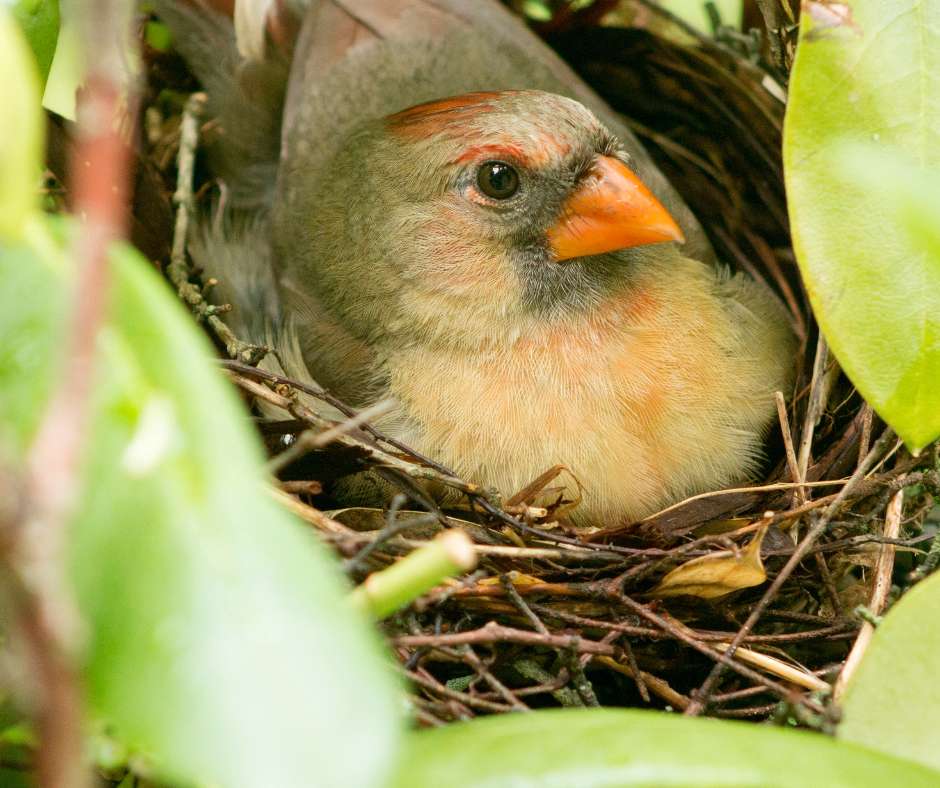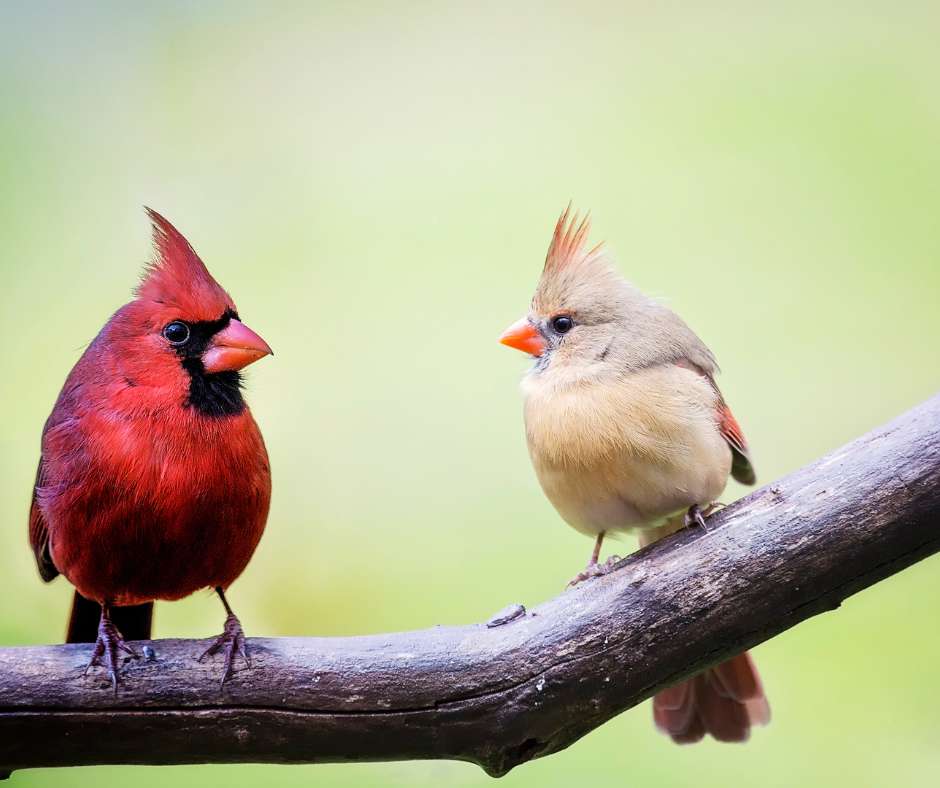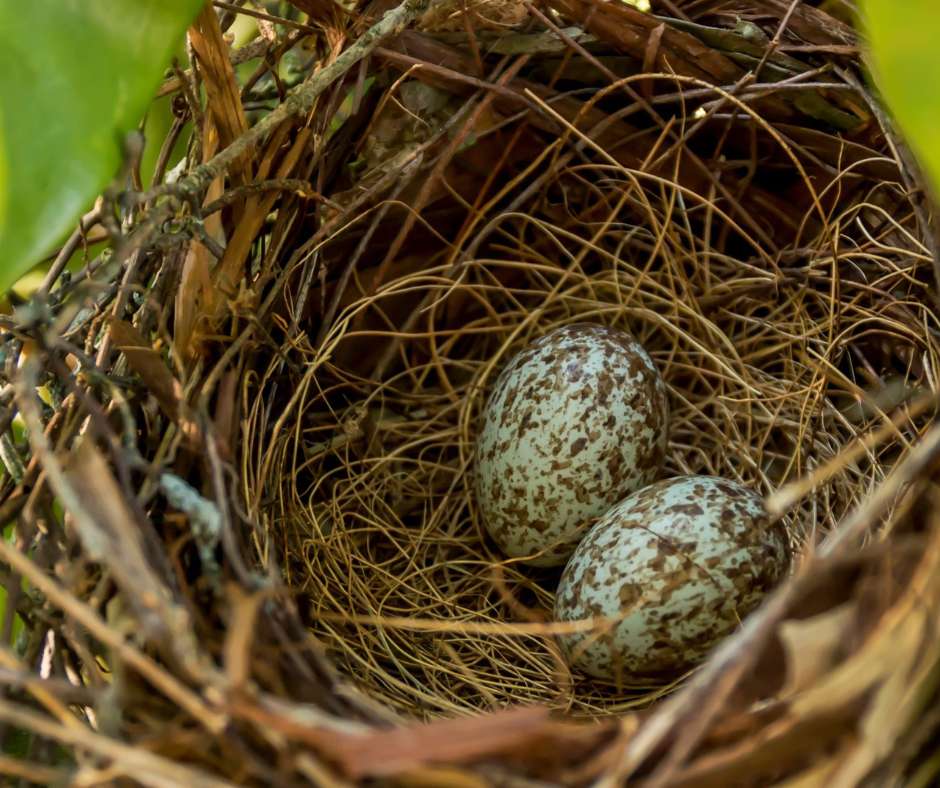The Northern Cardinal (scientific name: Cardinalis cardinalis), ignites landscapes with its crimson plumage and enthralls with its melodious song. Beyond this captivating exterior lies a hidden masterpiece: Cardinals nest.
While spring marks the peak of cardinal nesting activity, the female takes center stage in this architectural endeavor, meticulously weaving twigs, leaves, and other natural materials into a simple yet sturdy cup nestled within the dense foliage of a shrub or tree. Typically, these avian masterpieces rest a comfortable 5-7 feet above the ground, offering both security and an elevated vantage point for watchful parents.
Detailed Guide Of Cardinal Nests
This article delves into the avian architecture of Cardinal nesting, dissecting site selection, intricate construction, and the heartwarming ballet of raising a family.
Within, awaits a comprehensive table illuminating the multifaceted tapestry of the Cardinal’s existence, from preferred habitats and captivating calls to complex social dynamics. Join us in unveiling the secrets of the crimson cradle.
| Cardinal Nest Feature | Details |
| Location | Evergreen trees, branches of trees, dense shrubs, vines, or low trees (usually 3-10 feet above ground) |
| Construction | Built primarily by the female cardinal |
| Structure | Cup-shaped, made of twigs, weeds, grass, bark strips, leaves, rootlets, lined with fine grass or hair |
| Size | Typically 2-3 inches tall, 4 inches across, with an inner diameter of about 3 inches |
| Contents | Eggs (usually 2-5 per clutch), baby cardinal chicks |
| Building materials | Pine needles, plant materials, twigs, stems, strips of grapevine bark |
| Incubation period | 11-13 days |
| Nestling period | 7-13 days |
| Nest reuse | Not typically reused |
| Predators | Snakes, squirrels, cats, crows, blue jays |
| Threats | Habitat loss, Brown-headed Cowbirds (which may parasitize nests) |
| Conservation | Protected by law in Bangladesh and many other countries |
| Nesting season | Spring and early summer (can vary by region) |
| Nesting sites | Often near bird feeders or other food sources |
| Role of male cardinal | Defends nesting territory, sings to attract mate, may help feed female during incubation |
| Role of female cardinal | Builds the nest, incubates the eggs, feeds the chicks |
Nest Location
Northern Cardinals meticulously craft their nests within the verdant tapestry of shrubs and trees, favoring dense foliage and a secure height between 5-7 feet above the ground.
While they exhibit strong fidelity to their breeding territory, each year witnesses the construction of a brand new avian masterpiece, ensuring a pristine environment for their precious offspring.
This adaptive species readily thrives in suburban landscapes, readily utilizing backyard havens. Unlike cavity-nesting birds, Cardinals embrace their architectural independence, weaving intricate cup-shaped nests amongst the branches.
Their arboreal preferences are diverse, encompassing maples, pines, cedars, and even black locusts, with some ambitious builders venturing as high as 40 feet for optimal protection.
So, next time you find yourself amidst nature’s embrace, keep your gaze turned upwards, seeking the telltale chirps and leafy knots that may conceal a hidden marvel – the cardinal nest, a testament to avian ingenuity and the heartwarming miracle of family creation.

Nest Appearance
Cardinal nests epitomize avian architecture at its most functional. These meticulously crafted structures, typically woven from twigs, leaves, and grass, assume a simple cup-shaped form, optimally designed to cradle and protect their precious contents.
Resembling a cupped hand lined with soft moss and feathers, these nests average a modest 4 inches in diameter and 2-3 Inches in height, perfectly sized for the delicate eggs and chicks that reside within.
While their size may be modest, the intricate construction and meticulous placement within dense foliage speak volumes about the dedication and skill employed by the cardinal parents, ensuring a safe and secure haven for their young.
Phenology
The Northern Cardinal’s nesting season unfolds like a grand operatic cycle. As winter loosens its grip, typically in late February or March, the curtain rises on nest construction.
The female weaves a simple, cup-shaped nest, approximately four inches wide and two to three inches deep, using twigs, leaves, and other natural treasures. This stage can last until April, when the first delicate eggs are laid, usually in March or April.
The incubation period, a tense and watchful vigil, stretches for eleven to thirteen days. Once hatched, the chicks remain in their leafy cradle for another nine to ten days before taking their first tentative flights.
But this isn’t the end of the show! Cardinals can continue this nesting cycle up to four times in a season, their dedication and resilience ensuring the continuation of their vibrant lineage.
When winter’s curtain falls, the cardinals adopt a different role, joining communal flocks that seek shelter in the trees and bushes, waiting patiently for spring’s grand return.

Nest Construction
Nest construction in Cardinals, the Northern Cardinal, unfolds as a meticulously staged avian ballet. The female takes center stage, transforming twigs, leaves, and fibrous materials into a simple yet sturdy cup-shaped structure.
This architectural feat commences in late winter, often February or March, and sees her meticulously weave the chosen materials five to seven feet above the ground. While the male may occasionally contribute materials, the architectural responsibility rests solely with the female.
Her tireless efforts culminate in a haven approximately four inches in diameter and two to three inches in height, designed to cradle and protect future offspring. This intricate and dedicated process underscores the remarkable maternal instincts and avian ingenuity of the Cardinals.
- Timing: Starts in late winter (February/March)
- Location: Dense foliage, 5-7 feet above ground
- Builder: Female Cardinal (male may occasionally contribute)
- Materials: Twigs, leaves, bark strips, rootlets, pine needles, fine grasses
- Structure: Cup-shaped, sturdy base with woven walls, soft lining
- Size: 4 inches diameter, 2-3 inches height
- Purpose: Cradle and protect offspring
Cardinal Eggs
The cardinal nest, a meticulously woven haven nestled within the verdant tapestry of nature, becomes the stage for a captivating avian drama. Within its confines lie the delicate treasures – Cardinals eggs.
These orbs, typically numbering three to five, boast a subtle elegance, their pale green or buff-white canvas adorned with gentle speckles of brown. The female cardinal, the architect and guardian of this fragile realm, shoulders the noble duty of incubation, her unwavering dedication spanning 11-13 days.
Meanwhile, her mate transforms into a steadfast provider, diligently ensuring a steady flow of sustenance for both the incubating mother and the soon-to-be fledglings.
This synchronized dance of parental devotion culminates in the chicks’ departure, their tentative wings taking them into the world after a mere 9-10 days within the nest’s embrace.
Depending on the whims of nature, a cardinal pair may raise up to three broods in a single season, each a testament to their unwavering commitment to their offspring.
Thus, the cardinal nest, a microcosm of avian ingenuity and parental love, serves as a poignant reminder of the exquisite beauty that unfolds within the hidden corners of our natural world.

People Also Asked
Do Cardinals abandon their nests?
While Cardinals rarely abandon their nests, extreme circumstances like predator attacks, disease, or severe weather disturbances can force them to do so. If you suspect abandonment, observe from a distance for a few days before intervening.
Do Cardinals nest on the ground?
No, Cardinals do not nest on the ground. They prefer the safety and security of dense vegetation in shrubs and trees, typically 5-7 feet above the ground. Their nests are woven cups made of twigs, leaves, and other materials, offering their offspring protection from predators and the elements.
Where do Cardinals nest at night?
Unlike their nest, which is specifically built for raising their young, Cardinals do not “nest” at night in the same sense. Instead, they roost for the night in sheltered locations within trees and shrubs.
How to attract nesting Cardinals?
Entice fiery Cardinals to nest in your backyard! Plant dense shrubs and native fruit trees for privacy and food. Offer nesting boxes or natural sites 5-7 feet up, away from noise. Keep feeders stocked with sunflower seeds and safflower, and provide a clean water source. Minimize disturbance during nesting season (March-August). Patience is key, but soon you’ll be rewarded with the joyous melodies of fledglings!
Do Cardinals sleep with their babies?
Yes, Cardinal parents do sleep with their chicks in the nest for the first few days after they hatch. This close contact helps keep the chicks warm and protected, both from the elements and potential predators. The mother cardinal plays a crucial role in this period, brooding over the chicks to regulate their temperature and provide comfort. However, as the chicks grow and their feathers develop, they’ll start venturing out of the nest during the day and eventually sleep outside the nest entirely at night.
Can you move a Cardinal nest?
Moving a cardinal nest is illegal and harms the birds. They’ll likely abandon it, and even careful relocation often fails. Explore alternatives like barriers or seek expert advice to coexist peacefully with these vital ecosystem members.
Warp Up
We’ve marveled at meticulous site selection, a symphony of instinct and knowledge. We’ve admired the architectural prowess, each nest a brushstroke of twigs and leaves, secured with avian engineering. And most importantly, we’ve witnessed the heartwarming ballet of raising a family, chirps and fluttering wings composing a life-affirming melody.
But our avian adventures extend far beyond the Cardinal’s cradle. From hummingbird courtship rituals to monarch butterfly migrations, we delve into the remarkable lives of our feathered and winged friends.
So, fellow bird enthusiasts, make this blog your sanctuary. Check in regularly, for we promise to unveil the hidden wonders of the avian kingdom, leaving you breathless with awe and brimming with love for these feathered marvels.

